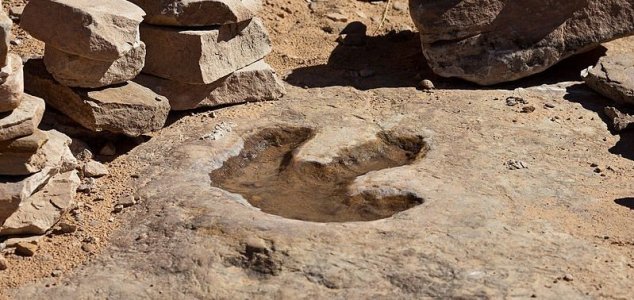Palaeontology
September 26, 2013 · 6 comments
6 comments

The team found large numbers of prints. Image Credit: CC BY-SA 2.0 Greg Willis
"We found dinosaur footprints by the scores on literally every outcrop we stopped at," said researcher Paul McCarthy. "I've seen dinosaur footprints in Alaska now in rocks from southwest Alaska, the North Slope and Denali National Park in the Interior, but there aren't many places where footprints occur in such abundance."
The discovery of an area so rich in fossil footprints is very rare and is being hailed as highly significant. The prints seem to come from a wide variety of different dinosaurs and are so abundant that it's possible to come across up to 50 specimens in as little as ten minutes.
"We found a great diversity of dinosaur types, evidence of an extinct ecosystem we never knew existed," said museum curator Pat Druckenmiller.
Source: Live Science | Comments (6)
Thousands of dinosaur tracks discovered
By T.K. RandallSeptember 26, 2013 ·
 6 comments
6 comments
The team found large numbers of prints. Image Credit: CC BY-SA 2.0 Greg Willis
A veritable treasure trove of dinosaur footprints has been found along the side of Alaska's Yukon river.
A research term exploring the region came across thousands of fossilized dinosaur tracks along the shoreline. Consisting of scientists from the University of Alaska's Museum of the North, the team traveled over 500 miles down the Tanana and Yukon rivers and returned with more than 900kg of footprint fossils."We found dinosaur footprints by the scores on literally every outcrop we stopped at," said researcher Paul McCarthy. "I've seen dinosaur footprints in Alaska now in rocks from southwest Alaska, the North Slope and Denali National Park in the Interior, but there aren't many places where footprints occur in such abundance."
"We found a great diversity of dinosaur types, evidence of an extinct ecosystem we never knew existed," said museum curator Pat Druckenmiller.
Source: Live Science | Comments (6)

The Unexplained Mysteries
Book of Weird News
AVAILABLE NOW
Take a walk on the weird side with this compilation of some of the weirdest stories ever to grace the pages of a newspaper.
Click here to learn more

Support us on Patreon
BONUS CONTENTFor less than the cost of a cup of coffee, you can gain access to a wide range of exclusive perks including our popular 'Lost Ghost Stories' series.
Click here to learn more
United States and the Americas
UK and Europe
Earth, Disasters and the Environment
Space: Astronomy and Astrophysics
Total Posts: 7,604,480 Topics: 316,290 Members: 201,819
Not a member yet ? Click here to join - registration is free and only takes a moment!
Not a member yet ? Click here to join - registration is free and only takes a moment!

























Please Login or Register to post a comment.